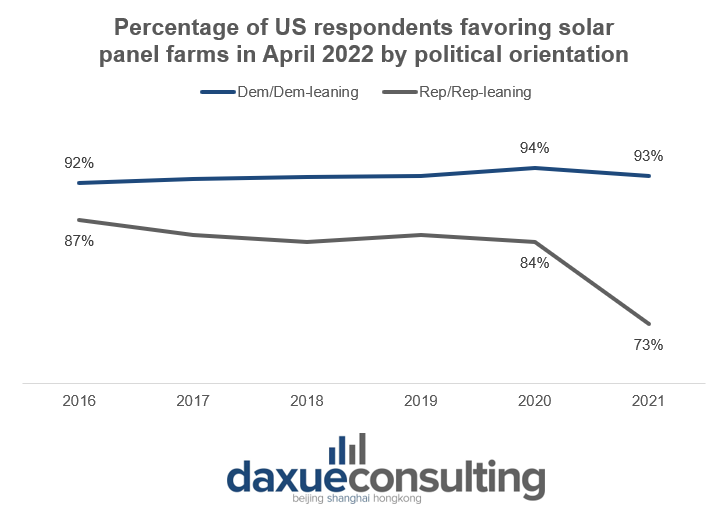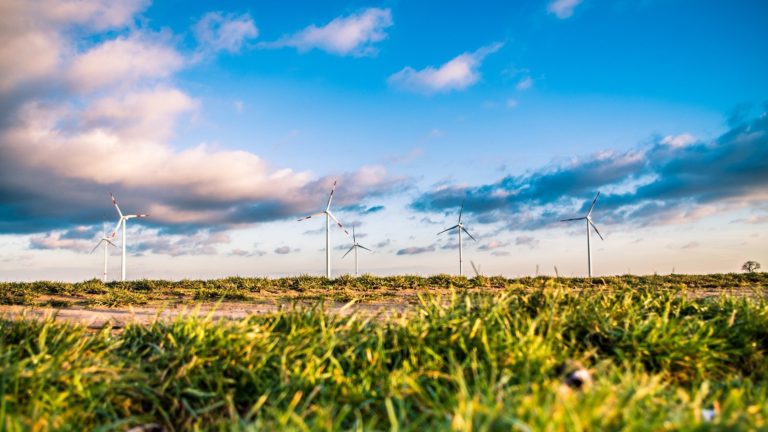Chinese companies are a dominant force in the world’s solar market, accounting for 46% of renewable generating capacity in 2021. Likewise, the American solar energy sector is also booming, expected to continue growing at an average rate of 8% annually through 2022. According to Bloomberg, total US investment in clean energy could reach 2 trillion USD by 2040.
The US solar market has been growing steadily over the past few years, with annual solar installations reaching 10.6 GW in 2018. While this is lower than China’s total installed capacity of around 100 GW, it’s still a large market opportunity for Chinese companies looking to enter the US market.
However, it has been difficult for Chinese solar companies to break into the US market, even as opportunities expand. In this article, we will discuss the possible ways in which Chinese companies can enter and succeed in the American solar market.
American consumer sentiment on solar energy
To combat the consequences of climate change, many Americans are becoming more aware of how they use energy at home (a trend that’s also growing in mainland China) —and this awareness translates into consumer demand for renewable sources such as solar power through programs such as net metering (a way for homeowners with rooftop solar panels to sell extra electricity back into the grid). Americans are consequently willing to pay more for renewable energy sources, making solar power likely to become an increasingly important source of energy in the United States.
Not to mention that switching to solar energy is also cheaper for the American consumer. It’s already less expensive than traditional fossil fuels and still decreasing in price as time goes on, so it’s no wonder that more and more people are using solar panels on their homes—saving money while also helping protect the environment.
The US Energy Information Administration estimates that the average American household spends about 1,400 USD annually on electricity, with the average resident using 892 kilowatt-hours monthly.
However, the data is polarized between the Democratic and Republican parties; while Americans generally have a favorable view of sustainable energy sources, Republican Americans increasingly disagree. Their support for solar power has dropped from 84% in 2020 to 73% in 2021.

President Joe Biden’s Policies
In his 2020 campaign announcement, Biden emphasized the importance of renewable energy by pledging for the US to generate 100% clean electricity by 2035. He also said that he wants to invest in clean energy technology, reduce the amount of carbon dioxide in the atmosphere and reduce the amount of fossil fuels used in the US.
On July 27th, 2022, the Biden-Harris administration announced a plan to connect families to low-cost solar power through the Department of Housing and Urban Development. This sets the stage for 4.5 million families to be able to tap into local community solar resources.
This is alongside another initiative to connect states to low-cost solar power. The new Community Solar Subscription Platforms (currently to be piloted by Colorado, Illinois, New Jersey, New Mexico, New York, and Washington DC) is designed to connect low-income households with community solar electric bills saving projects, possibly leading to over a billion annual savings for combined electric bills.
The job market should also expand as Biden aims to supply new workforce programs for the solar industry; using the Advancing Equity Through Workforce Partnership to provide 10 million USD in funding to develop inclusive workforce programs for deploying solar energy technologies.
This could mean a significant increase in demand for Chinese solar panels, with companies like JA Solar benefiting immensely.
Solar Superstars: Optimal Locations for Solar Installation
The US West Coast and southern states like Florida, Texas, and Georgia have some of the best locations in the country to host solar energy. These areas experience high levels of sunlight and low amounts of cloud cover, as well as very little rainfall, making them ideal for solar power generation.
But the current top 5 cities producing the most solar power are:
- Honolulu, Hawaii
- Las Vegas, Nevada
- San Diego, California
- Albuquerque, New Mexico
- San Jose, California
As major sources of electricity demand, cities play a crucial role in energy transition. In 2014, just 8 out of 56 big US cities surveyed by the Environment California Research & Policy Center vaunted a solar photovoltaic capacity of more than 50 watts installed per capita, while they were 34 in 2022.
Challenges to Solar Power
Despite opportunities for growth and expansion, there are many roadblocks that could prevent solar power from catching on. The cost of solar panels, the cost of installation and maintenance, the cost of energy storage, and other issues all need to be addressed before this clean energy source can become a viable alternative for most people.
Other threats include solar power efficiency and solar power intensity. Solar power efficiency refers to the amount of solar energy a panel can convert into actually usable energy; an average solar panel is less than 20% efficient, letting much of the energy go to waste. Solar power intensity is the issue of varying solar intensities throughout the year, as the amount of energy the sun provides isn’t uniform over land or time. Solar energy is more prevalent in certain locations than others (sunny Arizona versus rainy New England), and varies throughout the months (more sunshine in July than in December).
The threat is also there for traditional sources like coal and natural gas—if we stop burning these fuels in favor of renewable alternatives then it will directly impact their profitability. This could lead companies who rely on those fossil fuels to lobby against these new technologies or even try to undermine them by putting money into political campaigns at all levels (including local).
Where Does China Come In?
While China is the world’s largest market for solar panels, it has also been accused by the US government of dumping cheap solar panels on the US market to gain market share as well as intellectual property theft.
Regardless of whether these tactics are true, China is still the world’s largest market for solar panels, manufacturing about three-quarters of the world’s supply. But despite China’s dominance as a manufacturer of photovoltaic panels and other equipment used in solar power plants, American companies still lead when it comes to installation services (e.g., rooftop installation).
The US solar market is undergoing a phase transition from an installer-focused industry to one that focuses on energy management, distribution and storage, so opportunities lie in what happens after the panels are installed rather than during installation.
As a result, investors and businesses should consider opportunities such as:
- Energy storage companies that provide batteries for backup power for homes or businesses.
- Companies that connect energy users together for sharing resources (think Airbnb for energy).
- Companies providing smart meters, which allow consumers to track their energy usage and make smarter decisions about using it wisely.
The golden age of US solar energy has arrived, with lots of opportunities for Chinese companies to tap into it – especially if they look beyond installation services and focus on the overall experience post-installation. Chinese businesses should look at the overall experience that customers have with their company, and guarantee A-Z satisfaction.

Tapping into US solar power market
- While China remains the dominant force in the solar energy market, American growth is strong, with investment levels possible reaching 2 trillion USD by 2040.
- Both American and Chinese consumers are becoming more eco-conscious and leaning towards sustainable lifestyles.
- The Biden-Harris administration has enacted several policies to connect low-income communities with accessible sources of solar power, and continues to expand the job force in the solar industry.
- The most optimal places for solar power installation in the United States are cities located either on the West Coast or the South.
- The competition from traditional fossil fuels as sources of power, geographic inconsistency of solar power, as well as the general expenses of setting up and maintaining solar panels, all remain obstacles for the American solar energy market.
- China manufactures about 75% of the world’s solar panels, but it’s the United States that leads when it comes to the actual installation processes.
Author: Gloria Tsang





